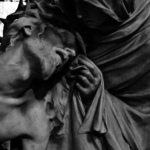We run our website the way we wished the whole internet worked: we provide high quality original content with no ads. We are funded solely by your direct support. Please consider supporting this project.

Conflicting Pictures of God
In my ongoing reflections on the ReKnew Manifesto, I’ve spent the last two posts (here and here) arguing that nothing is more important in our life than our mental images of God. If so, then the all-important question is: what authority do we trust to tell us what God is like? To most evangelicals, the answer is obvious: “the Bible.” If the Bible is the one and only inspired Word of God, what other answer could one possibly give?
I fully agree that the Bible is the inspired Word of God, but I think we have to be careful saying we should base our mental picture of God on this. For this would suggest that all of its various portraits of God have equal authority to tell us what God is like. In this case, for example, the portrait of God telling his people to “destroy [the Canaanites] totally” and to “show them no mercy” (Deut 7:2) as well as the multitude of pictures of God engaging in horrific violence would have the same authority to reveal God to us as the portrait of God revealed in Christ. Every violent portrayal of God in the Old Testament would be on a par of the portrait of God giving his life for his enemies and praying for their forgiveness with his last breath that we find in the crucified Christ. In other words, Christ would comprise only part of our mental image of God, but not the whole image.
In this light, it’s not surprising that so many Christians have conflicted images of God. Luther and Calvin, for example, celebrated the beautiful love and mercy of the God revealed in Christ, but they also both spoke of a dark side to God that is hidden behind the cross. Though he’s revealed in Christ to be full of love, both of these theologians envisioned another side of God which predestines all the evil that comes to pass and even decrees that the majority of humans spend eternity in hell. In his Institutes of the Christian Religion, Calvin himself called the decree of damnation “a horrible decree.”
It’s been my experience that, by virtue of giving all portraits of God equal authority to define our image of God, most Christians have, to one degree or another, a composite image of God in which Christ represents the “loving side” of God while the Father represents a side that is capable of engaging in behaviors that seem the opposite of loving – like predestining Auschwitz and the damnation of untold numbers of people. And with such amalgamated mental pictures of God, it’s not surprising that so many find it hard to passionately love God or get all their LIFE from God.
I agree that the Bible is the inspired Word of God, but as we’ll begin to see in my next post, the Bible itself teaches us that we are not to give every portrait of God equal weight. We’ll see that God has, throughout history, condescended to whatever level he needed to in order to relate to people where they were. And this meant that God often had to take on appearances that conceal more of his true character than they reveal it. Only in Christ do we find the truth of what God is really like.
Image by Derrick Tyson. Used in accordance with Creative Commons. Sourced via Flickr.
Category: General
Tags: Bible, Jesus, Picture of God, ReKnew
Related Reading

God is Not…
You just have to love this song by Gungor. Hope it blesses your socks off like it did us. (Thanks Jan Willem!)

The “Christus Victor” View of the Atonement
God accomplished many things by having his Son become incarnate and die on Calvary. Through Christ God revealed the definitive truth about himself (Rom 5:8, cf. Jn 14:7-10); reconciled all things, including humans, to himself (2 Cor 5:18-19; Col 1:20-22), forgave us our sins (Ac 13:38; Eph 1:7); healed us from our sin-diseased nature (1…

God is Like a Trojan Horse
Yesterday, I introduced a basic understanding of the Christus Victor view of Christ’s work on the cross. [Click here to read it.] Today, I want to expand on this briefly. Because God is a God of love who gives genuine “say-so” to both angels and humans, God rarely accomplishes his providential plans through coercion. God…

The Cruciform Beauty of Horrific Divine Portraits
“Only a person who is aware of the crucified Christ can properly understand Scripture.” Luther (Table Talks) In the last three posts I’ve been wrestling with how insights from Matthew Bate’s book, The Hermeneutics of the Apostolic Proclamation might help us interpret violent portraits of God in the OT in a way that discloses how…

A Foolish and Weak-Looking God
The New Testament assumes that the God of Israel and the God revealed in Jesus Christ are one and the same God. But there also can be no question that the portrait of God that was unveiled when the Messiah arrived on the scene was in some respects quite different from what the OT had…
